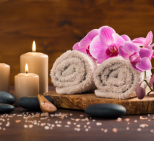- 79 Station Ln, Hornchurch, RM12 6JU
- 01708 607930
- info@charismabeautylounge.co.uk
- Home
- About Us
- Service
- Our Pricing
- Blog
- Contact

LATEST POST

Builder in a Bottle (BIAB) has transformed the nail industry, offering durable, glossy manicures that promise stronger nails. Loved for its ability to promote natural nail growth, BIAB is a go-to for many. Yet, the question lingers: does BIAB actually damage your nails, or is it a safe long-term option? The truth is, BIAB itself is not harmful to natural nails when applied and removed correctly.
In fact, it can serve as a protective layer that supports nail growth by adding strength and flexibility. Many users find their nails become longer and healthier with consistent BIAB use, especially when maintained properly. However, damage can occur if the product is removed incorrectly—such as picking or forcefully peeling it off—which can strip layers of the natural nail plate and cause thinning or sensitivity.
Over-filing during removal is another common issue that leads to nail weakening. To avoid these problems, it’s important to have BIAB applied and removed by a qualified nail technician who understands how to protect the natural nail underneath. Whether you prefer BIAB or want to try a Shellac nail in Hornchurch, professional application ensures both beauty and nail health. Regularly moisturizing your cuticles, using nail oil, and giving your nails occasional breaks between applications can also help maintain their health.
Proper BIAB application by a certified technician is key to avoiding nail damage. Trained professionals use minimal buffing and precise curing to protect nail integrity. Gel vs Acrylics. Improper techniques, like over-filing or thick layers, can weaken nails. Always choose a skilled technician to minimize risks.
Correct removal prevents BIAB from damaging nails. Soaking in Acetone for 15–20 minutes softens the gel for gentle removal with a cuticle pusher. Peeling or scraping BIAB can strip the nail’s top layer, causing thinning. Professional removal ensures nails stay healthy.
Nail health depends on pre-existing conditions, application quality, and aftercare. Brittle nails may struggle with BIAB, increasing the risk of damage. Frequent applications without breaks can stress nails over time. Proper care and professional handling reduce these issues significantly.
BIAB, or Builder in a Bottle, is a soak-off gel that strengthens natural nails. Its thick formula combines a primer, base coat, and builder gel. Cured under a UV or LED lamp, it forms a flexible, durable layer. This all-in-one design simplifies application while enhancing nail resilience.
BIAB application starts with nail prep, including cleansing, shaping, and light buffing. A technician applies thin BIAB layers, curing each for 60–90 seconds under a lamp. The result is a smooth overlay that supports nail growth. It’s versatile for overlays, extensions, or gel polish bases.
BIAB outperforms acrylics, which can weaken nails during removal. Hard gels are strong but brittle, often cracking under pressure. BIAB is lightweight and flexible, gentler than acrylics and less rigid than hard gels. Its soak-off nature minimizes damage compared to traditional enhancements.
Unlike dip powders (SNS), BIAB requires minimal nail prep, reducing abrasion. Acrylics often involve drilling, which can harm nails. BIAB’s flexibility mimics natural nail movement, preventing lifting or breakage. It’s ideal for those seeking durability without compromising nail health.
Many fear BIAB damages nails due to experiences with acrylics or dip powders. Improper application or removal can cause peeling or thinning. Social media horror stories amplify concerns, with users reporting brittle nails post-BIAB. These issues often stem from poor technique or lack of aftercare, and comparing Builder Gel vs BIAB can help highlight the differences in strength and safety.
A myth is that BIAB inherently harms nails. In reality, damage occurs only with improper handling. BIAB protects and strengthens nails, unlike harsh acrylics. Peeling BIAB or over-filing during prep causes harm, not the product itself.
BIAB acts as a protective shield, reducing breakage and splitting. Its flexible formula supports weak nails, promoting longer growth. Users often report stronger nails after consistent BIAB use. It’s perfect for nail biters or those with fragile nails.
BIAB manicures last 3–4 weeks, outlasting gel polish (2–3 weeks). Its flexibility prevents cracking, unlike hard gels. This durability reduces frequent touch-ups, minimizing nail stress. The glossy, chip-resistant finish enhances aesthetic appeal.
BIAB supports infills every 2–3 weeks, avoiding full removal each time. This reduces acetone exposure, preserving nail health. Infills maintain the manicure while allowing natural nail growth. Full removal is needed only every 3–4 appointments.
Some BIAB formulas, like The Gel Bottle’s, are HEMA-free, reducing allergy risks. HEMA (hydroxyethyl methacrylate) can cause sensitivities in some users. HEMA-free BIAB is gentler, ideal for sensitive nails. This makes BIAB accessible to more people.
Select a certified nail technician trained in BIAB application. Professionals understand proper prep, application, and removal techniques. They avoid over-filing and ensure even curing, reducing damage risks. Check salon reviews and credentials before booking.
Proper aftercare maintains nail health with BIAB. Apply cuticle oil daily to hydrate nails and cuticles. Avoid using nails as tools to prevent lifting or chipping. Wear gloves during chores with water or chemicals to protect the manicure.
Never peel BIAB, as this damages the nail bed. Soak nails in acetone-soaked cotton pads wrapped in foil for 15–20 minutes. Gently push off softened BIAB with a cuticle pusher. Visit a professional for removal if unsure.
Take breaks between BIAB applications to let nails recover. Experts suggest full removal every 3–4 appointments, followed by a 1–2 week break. This prevents overexposure to gel products or Acetone. Healthy nails support better BIAB results.
Request a patch test if you have allergy concerns. Apply BIAB to one nail and monitor for reactions over 24–48 hours. This identifies sensitivities to ingredients like HEMA. Choose HEMA-free BIAB if needed.
Watch for peeling, thinning, or discoloration after BIAB removal. Brittle or flaky nails may indicate over-filing or improper removal. Redness or soreness around the nail bed suggests irritation. Persistent symptoms require professional attention.
Pause BIAB applications if nails appear weak or discolored. Allow 1–2 weeks for recovery with nourishing oils and strengtheners. Persistent issues like pseudomonas (green discoloration) need immediate care. Regular nail checks during infills prevent long-term damage.
Apply cuticle oil and nail strengtheners to repair minor damage. Avoid enhancements until nails regain strength. Consult a dermatologist for severe issues like infections. Early intervention promotes faster recovery.
Giorgia Cappella, head educator at The Gel Bottle, says BIAB promotes nail growth when applied correctly. Its flexibility reduces breakage compared to acrylics, she notes. Technician Shirley Cheng reports healthier nails in BIAB clients due to minimal removal needs. Proper technique is critical, they agree.
Cosmetic chemist Kelly Dobos states BIAB’s formula is less harsh than acrylics, lowering damage risks. Users like Rebecca Davis report stronger nails after switching to BIAB from SNS. Improper removal can cause peeling, experts warn. Scientific data on BIAB is limited, but professionals support its safety.
Experts emphasize that training prevents BIAB from damaging nails. Courses like TGB Academy’s teach safe techniques. Untrained technicians may over-file or rush removal, causing harm. Verify your technician’s credentials for optimal results.
Does BIAB damage your nails? When applied and removed correctly, BIAB strengthens nails without harm. Its flexibility, durability, and infill-friendly nature make it gentler than acrylics or hard gels. By choosing a certified technician, following aftercare, and monitoring nail health, you can enjoy stunning BIAB manicures safely.
Recent Posts




WhatsApp us
